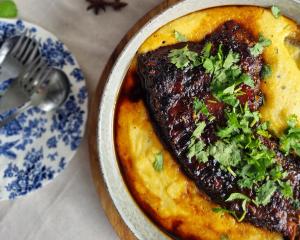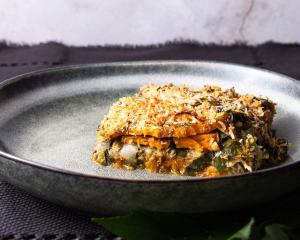When skies turn dark and temperatures plunge, out come the short lists of dishes to warm body and soul. To those should be added an easy to make and deliciously satisfying Moroccan-style chicken tagine, David Latt writes.

Making a tagine sounds exotic, but at its heart, the dish is a one-pot braise, a technique as basic as beef stew.
Traveling with half a dozen food writers on a hosted trip to Morocco, at the trekking hotel, Kasbah du Toubkal, we were given a cooking demonstration by Hajjah Rkia ben Houari ("Hajjah" is an honorific given to a woman who has completed a pilgrimage to Mecca) and her assistant Fatima.
In her kitchen with a view of the High Atlas Mountains, she showed us how to make classic Moroccan dishes: chicken tagine, preserved lemons and lamb couscous.
She started the lesson by reminding us that having quality, fresh ingredients is essential.
The chickens, lamb, fresh vegetables and herbs came from the nearby open-air market in the Berber village of Asni. The spices were from vendors, much like the ones we saw in the Marrakesh and Fez souks with their finely ground spices organized in mounds next to bushels filled to overflowing with olives, dates, dried fruit, dried beans and herbs.
Home cooking in the High Atlas Mountains
In the pantry between Hajjah Rkia's kitchen and the laundry room, sitting on short stools around a low table, we felt a bit like nursery school kids on a field trip. With our knees bumping against the table, we were her prep chefs. She assigned tasks - peeling onions, garlic, carrots and potatoes - and the translator explained how we would cook the dish according to our host's Berber traditions.
At the end of the cooking demonstration, Hajjah Rkia's son made Moroccan-style mint tea, which meant the teapot was held high in the air as a hot stream of black tea flavored with fresh mint was poured into small glass cups. He explained the long stream aerated the tea and gave it added flavor qualities. Without the benefit of a test kitchen, we couldn't validate that opinion, but we loved the spectacle and the tea was delicious.
Just before we sat down for dinner, Fatima cooked flat bread on an outdoor clay stove fueled by wood and charcoal. Charred on the outside, the bread was chewy on the inside. To stimulate our appetites, Fatima's handmade bread arrived at the table warm from the fire with a plate of fresh feta cheese and a bowl of spicy Moroccan olives. Then the table was set with large platters of the dishes made during the cooking demonstration. What a feast.
Translating Moroccan classics
Back in my own American kitchen, facing an inclement day when friends were coming over for dinner, I remembered that wonderful meal at Hajjah Rkia's. The chicken tagine appealed to me as the perfect way to beat back the cold. I adapted the recipe to my own palate and the realities of a Southern California kitchen.
In Morocco the pot used to prepare a tagine is a shallow pan with a distinctive conical top. Lacking a tagine, I find the qualities of the dish can be approximated using a covered pot that has a vented lid to promote the thickening of the sauce through evaporation. I use an inexpensive Chinese clay pot, which works well.
Before using a clay or ceramic pot, always check the manufacturer's instructions. Some pots should be soaked in cold water before using. For some pots, a diffuser must be placed between the pot and the heat source to prevent cracking.
Chicken with preserved lemons, cracked olives and golden raisins
Preserved lemons give the dish a bright, citrus finish. Easy to make at home, preserved lemons will keep refrigerated for months. The lemons can be used after one week, although the longer they have been preserved, the more they will have their distinctive "perfume" flavor.
As a side dish, Moroccan pickled vegetables provide a tangy complement to the savory tagine. The pickles are fun to make and, like the lemons, will keep refrigerated for months.
This recipe calls for cracked olives, which are olives that have been "cracked" sometimes by hand, sometimes by machine to create a deep cut in one side of the olive reaching to the pit. That allows the brine to reach deep into the olive.
In cracked olives, the pits are mostly separated from the "meat" because of the cracking. The advantage of cracked olives in a braised dish is the sauce soaks deeply into the olives and the saltiness of the olive passes into the sauce so the effect is different from using regular olives.
Serves 4
Ingredients
1 whole chicken, (1.3kg-1.8kg), washed
¼ cup salt
¼ cup golden raisins
1 tablespoon ground black pepper, divided
3 tablespoons lemon juice
4 garlic cloves, peeled
⅓ bunch fresh coriander (cilantro), stems and leaves
1 tablespoon olive oil
1 medium red or yellow onion, peeled, finely chopped
1 teaspoon ground ginger
¼ teaspoon of powdered saffron (optional)
⅛ teaspoon cayenne powder (optional)
2 cups chicken stock (preferably homemade)
1 preserved lemon, rinsed, white pith removed, finely chopped
1 cup cracked green olives
Sea salt and black pepper to taste
⅛ teaspoon cayenne powder (optional)
Method
1. Place the whole chicken in a large container, cover with water. Add the salt. Refrigerate overnight.
2. Place the golden raisins, ¼ teaspoon of the black pepper and lemon juice into a covered container. Allow the raisins to absorb the juice for at least one hour or overnight.
3. Before cooking, rinse the chicken and pat dry. Using a sharp knife, remove the breast meat, legs, thighs and wings from the carcass. Cut apart the wings at the joints. Debone the thighs and legs, taking off the skin.
4. Place the carcass, skin and wing tips into a large pot, cover with water and simmer 60 minutes. Strain the bones. Reserve the stock. The meat on the bones can be picked off and used in a salad or a soup. Refrigerate the chicken stock. When cooled, remove the fat and discard.
5. Finely chop the garlic and coriander.
6. Cut each chicken breast into four, equal sized pieces. Cut the deboned thighs into four and the legs into two pieces.
7. Over a medium flame, heat the olive oil in a tagine or pot. Add the onions, ground ginger, saffron (optional), garlic and cilantro. For additional heat, dust with cayenne powder (optional). Stir well and cook for two to three minutes.
8. Sauté the wings, thighs and legs in the seasoned oil until lightly browned. Do not add the chicken breasts, which require less cooking time.
9. Finely chop the raisins, which have now absorbed the pepper-flavored lemon juice.
10. Add raisins, remaining black pepper-lemon juice and chicken stock. Stir well to create the sauce. Cover and gently simmer 30 to 40 minutes or until the chicken meat is tender.
11. Add chicken breast pieces, cracked green olives and finely chopped preserved lemon peel.
12. Cover and simmer 20 minutes. Taste and adjust seasoning with sea salt or ground pepper. Serve hot with steamed rice as a side dish.
Variations
Do not debone the breast, thigh and legs. Traditionally, the chicken is quartered and the wings are kept whole.
Along with the onions, add other vegetables of your choice such as leeks, peeled potatoes, carrots, cauliflower and turnips, cut into bite-sized pieces.
For added sweetness, dissolve 1 tablespoon honey in the chicken stock.
Before adding the vegetables, lightly drizzle them with olive oil and roast for 15 minutes in a 180degC oven on a parchment-paper-lined baking tray.
Serve with steamed spinach instead of rice.
Serve with boiled or mashed potatoes instead of rice.
- By David Latt of Zester Daily / Reuters Media Express













